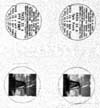

WONKO'S MICRODOT EXPERIMENTS--SECOND EFFORT
Well this was MUCH better. My strategy changed dramatically. Here are the changes:
-
Changed from Kodak 2484 (ASA 800) to Agfa APX 25 (Again from Goathill Photo)
-
Increased light.
-
Developed film myself.
The first (film) was a no-brainer. The grain was such an issue before, I didn't want to even look at anything that did not say "ultra-fine grain" in the description. I also realized that, due to the new film, both light and exposure time would need to be dramatically increased. In fact I used the white linoleum floor in our kitchen, with all the lights on. This was visibly brighter than my initial attempt.
The newest thing was developing the film myself. I had never developed black and white, and it had been twelve years since I had done color slides. This added a whole new element. The only developer that I found that was readily available (in stock, at an open store, after 5:00 pm. OK, so I'm not patient) was Kodak HC-110. I had hoped to find some PMK Pyro, but this is Utah and well, that would be too much to ask.
As before, I loaded the film (this time in a 15 shot segment) and shot a test roll using the my test sheet. I then began to develop the film. I used several sources for my times and methods. The main ones were The Sub Club's Darkroom Page, Godfrey DiGiorgi's Agfapan processing and developing tank guides, as well as the Agfa and Kodak pages.
I was going for contrast more than tonality, so I developed for 6 minutes, agitating for the first full minute, and agitating for 15-25 seconds every minute thereafter in a 1:31 solution at 20° c.
I will be honest, this was just going for down an dirty results. Because of this I did nothing to prevent dust, and even dried the negatives with a paper towel so I could look at them. Given more time I will take more care.
So what came out:
I was amazed at the difference from my initial tests. The lines and circles were all clear and distinct in the microscope. Amazingly I can read both the 7 and 6 point lines. I think that with better technique, and a better microscope, I should be able to clearly read the 5 point line and very probably the 4 point line.
This is actually not exactly accurate. Remember that the premise was a one inch circle would translate into a one millimeter circle on the negative. I also stated that the FOV of the microscope was approximately one millimeter. Well, somewhere my calculations are off because the circles only are about 3/4 of the FOV. This means that the type is also being reproduced even smaller than predicted, thus a larger font achieves the same results. I believe the discrepancy is due to the border surrounding the sheet of paper in the negatives.
Below are some scans. Keep in mind that my scanner cannot reproduce the detail that is created on this film. It can give an Idea of what is achievable.
This
was taken with a setting of 1/10th of a second. Notice how, even in the
thumbnail, the lines are clear and distinct. Compare this to my original
scan.
To give a better idea of resolution (again, note my scanner's limitations), I cropped some details at full size.
 Note
the detail in the co-centric circles and the bars.
Note
the detail in the co-centric circles and the bars.
 Even
with the excessive agitation, the windmills ended up surprisingly nice.
In all fairness, the B&W windmill looks NICER than the original. Take
that!
Even
with the excessive agitation, the windmills ended up surprisingly nice.
In all fairness, the B&W windmill looks NICER than the original. Take
that!
So, in summary, the reduction of text with a Minox to microdot size is not just possible, it is readily achievable.
My next experiments are going to involve the microscope blowing up the text with my Minox so I can scan it in. I will report the results here.
WONKO 12/8/2000
These pages are copyright 1995-2007 by Wonko's Web Pages.
All rights reserved. .
